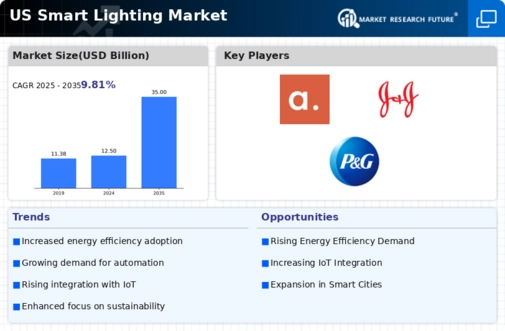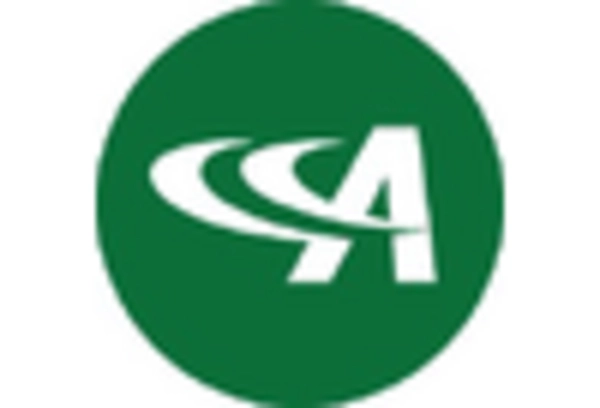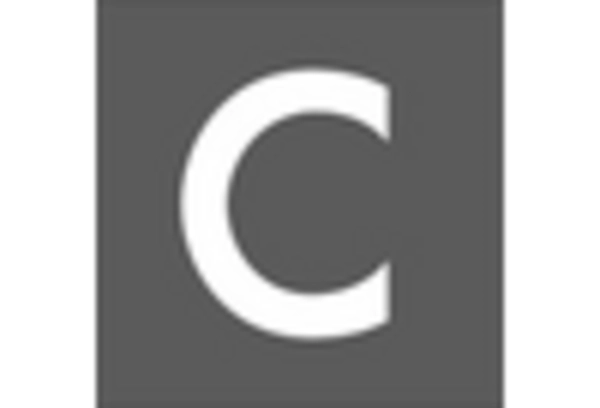Advancements in LED Technology
The rapid advancements in LED technology are significantly influencing the smart lighting market. LEDs are becoming increasingly efficient, with lifespans extending beyond 25,000 hours, which reduces the frequency of replacements and maintenance costs. The smart lighting market is leveraging these advancements to create products that not only consume less energy but also offer enhanced features such as color tuning and dimming capabilities. The integration of smart controls with LED technology allows users to customize their lighting experience, further driving adoption. As the cost of LED components continues to decline, the overall affordability of smart lighting solutions is expected to improve, potentially increasing market penetration across various sectors.
Regulatory Support for Energy Efficiency
Regulatory frameworks promoting energy efficiency are playing a crucial role in shaping the smart lighting market. In the US, various initiatives and incentives are being introduced to encourage the adoption of energy-efficient technologies. For instance, the Department of Energy has set ambitious targets for reducing energy consumption in buildings, which includes the implementation of smart lighting systems. This regulatory support not only fosters innovation within the smart lighting market but also provides financial incentives for consumers and businesses to invest in these technologies. As compliance with energy efficiency standards becomes increasingly mandatory, the demand for smart lighting solutions is likely to rise, further propelling market growth.
Integration with Renewable Energy Sources
The integration of smart lighting systems with renewable energy sources is emerging as a key driver for the smart lighting market. As the US shifts towards sustainable energy solutions, the ability to synchronize lighting systems with solar panels and other renewable sources is becoming increasingly attractive. This integration allows for optimized energy usage, reducing reliance on traditional power grids. The smart lighting market is exploring innovative solutions that enable seamless connectivity with renewable energy systems, which could lead to substantial cost savings for consumers. As the push for sustainability continues, the demand for smart lighting solutions that support renewable energy integration is likely to grow, fostering further advancements in the market.
Growing Demand for Energy Management Solutions
The increasing focus on energy management solutions is a pivotal driver for the smart lighting market. As businesses and consumers alike seek to reduce energy consumption, smart lighting systems offer an effective means to achieve this goal. According to recent data, the energy savings from smart lighting can reach up to 50% compared to traditional lighting systems. This trend is particularly pronounced in commercial sectors, where operational costs are closely monitored. The smart lighting market is responding to this demand by developing advanced technologies that allow for real-time monitoring and control of lighting systems. This not only enhances energy efficiency but also contributes to sustainability goals, making smart lighting an attractive option for environmentally conscious consumers and businesses.
Rising Consumer Awareness of Smart Technologies
Consumer awareness regarding the benefits of smart technologies is steadily increasing, which is positively impacting the smart lighting market. As individuals become more informed about the advantages of smart lighting, such as convenience, energy savings, and enhanced security, the market is witnessing a surge in demand. The smart lighting market is capitalizing on this trend by launching educational campaigns and user-friendly products that appeal to tech-savvy consumers. This heightened awareness is not only driving sales but also encouraging manufacturers to innovate and improve their offerings. As more households and businesses recognize the value of smart lighting, the market is expected to expand significantly.
















Leave a Comment